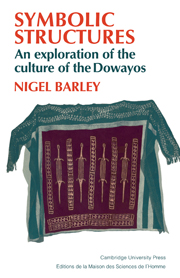Book contents
- Frontmatter
- Contents
- Acknowledgments
- Preface
- 1 The ethnographic background
- 2 Symbolism and the punctuation of culture
- 3 Some problems of the representational model of symbolism
- 4 The leopard cannot change his spots
- 5 Water and fertility
- 6 Tarniisnohgbarklele: ‘the place where the old Fulani woman was beaten to death’
- 7 ‘It is only thanks to me that you were circumcised’
- 8 The seasons of the year and the joker in the pack: relations of nesting and quotation
- Appendix: The festivals
- Notes
- Bibliography
- Index
7 - ‘It is only thanks to me that you were circumcised’
Published online by Cambridge University Press: 07 May 2010
- Frontmatter
- Contents
- Acknowledgments
- Preface
- 1 The ethnographic background
- 2 Symbolism and the punctuation of culture
- 3 Some problems of the representational model of symbolism
- 4 The leopard cannot change his spots
- 5 Water and fertility
- 6 Tarniisnohgbarklele: ‘the place where the old Fulani woman was beaten to death’
- 7 ‘It is only thanks to me that you were circumcised’
- 8 The seasons of the year and the joker in the pack: relations of nesting and quotation
- Appendix: The festivals
- Notes
- Bibliography
- Index
Summary
Thus far, we have looked at some of the simpler processes at work in culture, the punctuation into domains, themes, representational symbolism and basic forms of process relating one classification to another. The study of liminality involves a higher level of analysis, in that the marker ‘liminality’ already requires a preliminary categorisation before it can enter into other systems.
Liminality is portrayed in Dowayo culture above all in the classification of relationships. Kinship relations are firmly affective. Parents are warm and affectionate but sexuality must never be mentioned before mother or sister. Parents-in-law are treated with great respect. Sexuality is never to be mentioned. One should never look them directly in the face when speaking to them. A woman should adopt ‘respect posture’ (on knees, hands over genitals, face averted) when speaking to her husband's father, as should a man when speaking to his wife's mother. A man has a special relationship with his nephew or niece. They are expected to be mutually free and intimate. They may make free with each other's possessions. The relationship is of great ceremonial importance.
Quite distinct from these links are another series of relationships. In life a man acquires a number of ‘brothers of circumcision’, men who underwent circumcision in the same year as himself. Clearly, he cannot know every single man who was circumcised that year, especially if they are from the other end of Dowayoland. Out of this group, therefore, he will select some small number with whom he has regular contacts and these will become ‘his’ brothers of circumcision. Similarly, a woman acquires ‘sisters of circumcision’ who began menstruating in the same year as herself.
- Type
- Chapter
- Information
- Symbolic StructuresAn Exploration of the Culture of the Dowayos, pp. 70 - 79Publisher: Cambridge University PressPrint publication year: 1983

